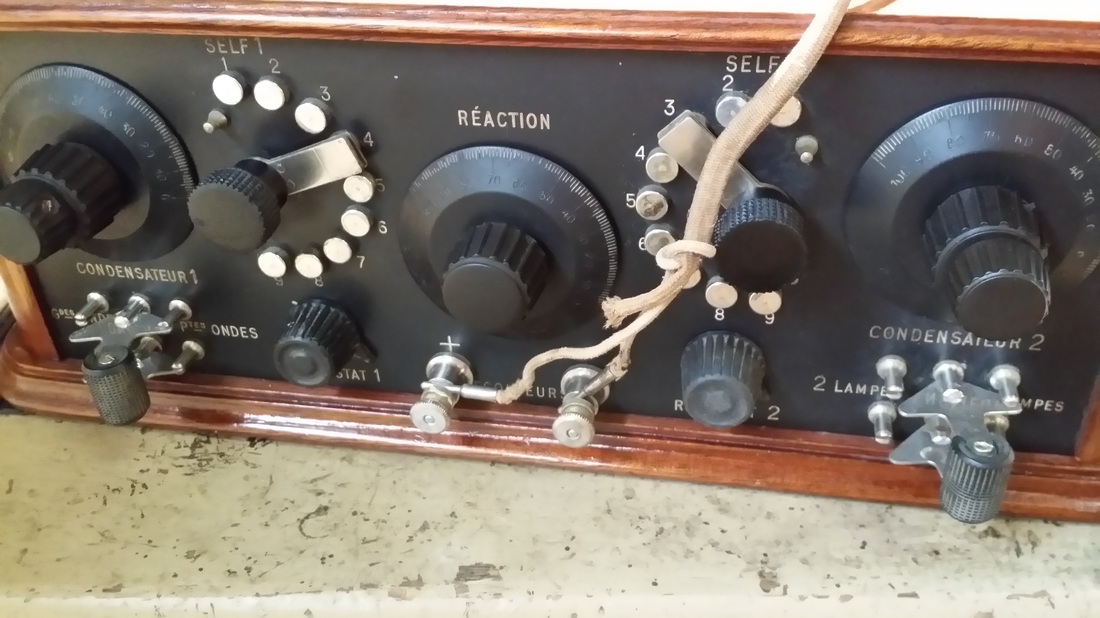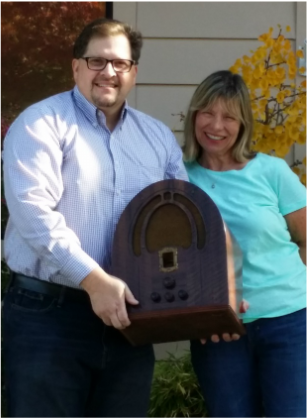But it wasn't homemade. Seems the French did this on almost all of the radios they made in the early 1920s.
I sent off a email to the seller. It is always a surprise when the reply is "Hi Russ" from somebody that I already know. This one was being offered by fellow radio collector and broadcast celebrity, Bill Meyer. Bill has a "morning drive" show on TWO of our local stations, KMED 1440 AM and 106.7 FM.
We drove down to the radio station where Bill had just finished his morning show. His asking price was $75 - - - Maybe I could wrastle him down to $20? Or on the other hand I could return the Philco 89 that he had given me earlier in the year, now restored.
I could tell Bill was dealing with the issues faced by all radio collectors - to wit: "Like I NEED ANOTHER Radio, I was Trying to GET RID of One". So, of course, he took the Philco instead of the $75. Whew! net gain for me - 0 new radios. Yet a very cool new set.
Bill had given me 4 boxed tubes with the radio that were known to be good, but other than that, I was on my own. Where was I going to get a schematic for a 1924 French radio that even most French radio collectors had never hear of. Or better yet, how do you get this cabinet apart? The internet is your friend ( or not, depending on what you post there ). I found a very nice French radio collector that had a picture of a very similar radio on his site. I sent of an email. His prompt reply:
Dear sir,
I have sold the radio you told me about in US, 15 years ago...perhaps it is yours because I think the Liotard radios are not numerous in US.
I have seen only a few of these radios in France, less than 5 I think, so it is rare.
I have no schematic and no more informations about it, the manufacturer was a small size one and he made radios only during a short period.
AND the answer to another valuable question:
Earth is T (Terre)
Antenna is C (C for Cadre = loop antenna)
Now I only had to use my French/English translation for the text on the front panel.
After figuring out how to get the cabinet apart - someone had glued the top, which turns out to be the bottom, on to the rest. Carefully picking at the white glue, I got the cover off.
While everything else was in wonderful shape, even the wires, which were centered with a small brad and then waxed to the bottom (top), I find that both interstage transformers had open windings.
So out comes the coil winder and about a mile of #39 enameled wire (yeah, really, about a mile!). First you have to get the old wire off of the coil form which is inside of the metal core. I have done a lot of American transformers. The laminated cores are a pain, but once you get one of them out, the slack lets the rest pretty much fall apart. NOT THIS ONE! Were was this made? Oh yah, they do things differently in France.
Video titled "DON"T TOUCH THAT DIAL" or that dial or that knob or that switch - - -
An observation: These radios could have much smaller cabinets than their American counterparts since the cabinet did not have to house the tubes. Note, the size of the Liotard 4 tube (lamp) sitting in front of the gigantic Federal 59, also having 4 tubes.
With fingers still too short,
Russ







 RSS Feed
RSS Feed